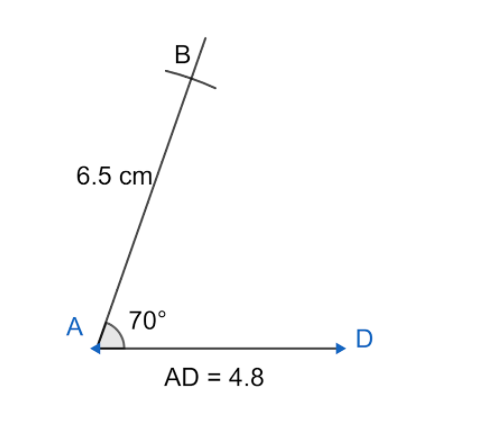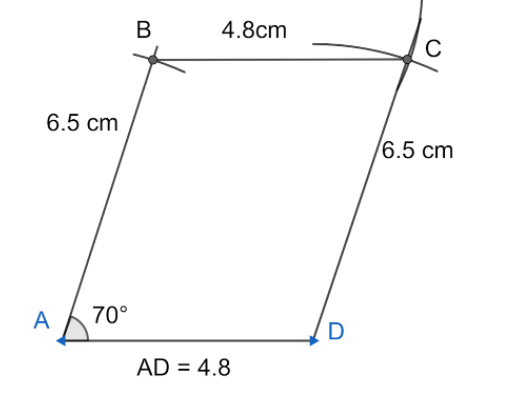
Draw a parallelogram \[ABCD\] in which \[AB = 6.5cm\] , \[AD = 4.8cm\] and \[\angle BAD = {70^ \circ }\] . Also measures its diagonal .
Answer
491.7k+ views
Hint: The first point we have remember that we have to the base of the parallelogram which is \[AD = 4.8cm\] , so as to construct the angle \[\angle BAD = {70^ \circ }\], from vertex \[A\] . Then draw the arc of given length from \[A\] using the compass .
Complete step-by-step answer:
Given : \[AB = 6.5cm\] , \[AD = 4.8cm\] , \[\angle BAD = {70^ \circ }\]
We will draw the parallelogram in following steps :
Step 1 –
Draw a line \[AD = 4.8cm\] , which provides the base for the parallelogram , we get

Step 2 –
Draw an angle of \[{70^ \circ }\] by taking the vertex \[A\] as center . Draw the angle using a protractor .

Step 3 –
Now , draw an arc of \[6.5cm\] by \[A\] as the center along the line of \[{70^ \circ }\] angle . Name it as \[B\] .

Step 4 –
Now from \[B\] cut an arc of \[4.8cm\] and from \[D\] cut an arc of \[6.5cm\] and name the point of intersection of both arcs as \[C\], as opposite sides of parallelogram are equal . At last join all the points we have

On measuring with a ruler we get the diagonals as \[BD = 6.6cm\] and \[AC = 9.2cm\] .

This is our required parallelogram constructed with given dimensions .
Note: A parallelogram is a simple quadrilateral . It has different properties which are as follows :
I.Opposite angles are equal .
II.Opposite sides are parallel and equal .
III.Diagonal bisect each other .
IV.Sum of any two adjacent angles is \[{180^ \circ }\] .
V.Opposite sides are congruent also
Complete step-by-step answer:
Given : \[AB = 6.5cm\] , \[AD = 4.8cm\] , \[\angle BAD = {70^ \circ }\]
We will draw the parallelogram in following steps :
Step 1 –
Draw a line \[AD = 4.8cm\] , which provides the base for the parallelogram , we get

Step 2 –
Draw an angle of \[{70^ \circ }\] by taking the vertex \[A\] as center . Draw the angle using a protractor .

Step 3 –
Now , draw an arc of \[6.5cm\] by \[A\] as the center along the line of \[{70^ \circ }\] angle . Name it as \[B\] .

Step 4 –
Now from \[B\] cut an arc of \[4.8cm\] and from \[D\] cut an arc of \[6.5cm\] and name the point of intersection of both arcs as \[C\], as opposite sides of parallelogram are equal . At last join all the points we have

On measuring with a ruler we get the diagonals as \[BD = 6.6cm\] and \[AC = 9.2cm\] .

This is our required parallelogram constructed with given dimensions .
Note: A parallelogram is a simple quadrilateral . It has different properties which are as follows :
I.Opposite angles are equal .
II.Opposite sides are parallel and equal .
III.Diagonal bisect each other .
IV.Sum of any two adjacent angles is \[{180^ \circ }\] .
V.Opposite sides are congruent also
Recently Updated Pages
Master Class 8 Social Science: Engaging Questions & Answers for Success

Master Class 8 Maths: Engaging Questions & Answers for Success

Master Class 8 Science: Engaging Questions & Answers for Success

Class 8 Question and Answer - Your Ultimate Solutions Guide

Master Class 8 English: Engaging Questions & Answers for Success

Why are manures considered better than fertilizers class 11 biology CBSE

Trending doubts
Which one of the following groups comprises states class 8 social science CBSE

Full form of STD, ISD and PCO

A couple went for a picnic They have 5 sons and each class 8 maths CBSE

What is the difference between rai and mustard see class 8 biology CBSE

Advantages and disadvantages of science

Differentiate between the farms in India and the U class 8 social science CBSE




